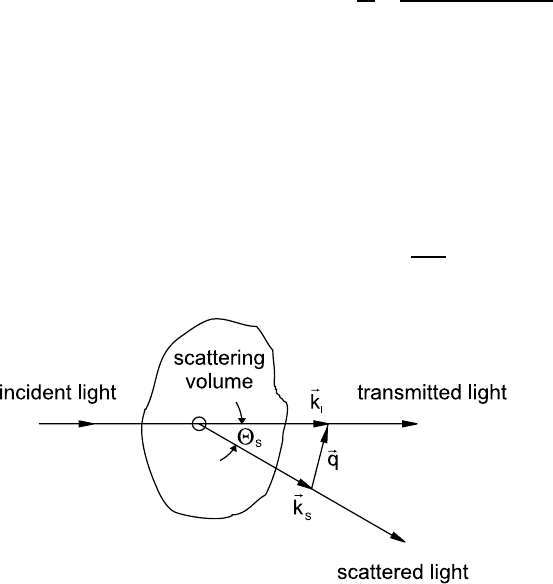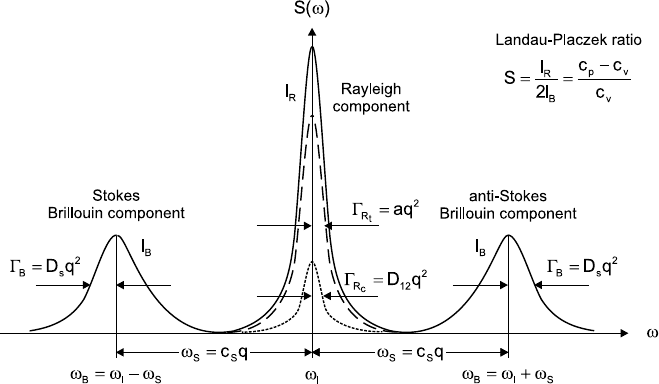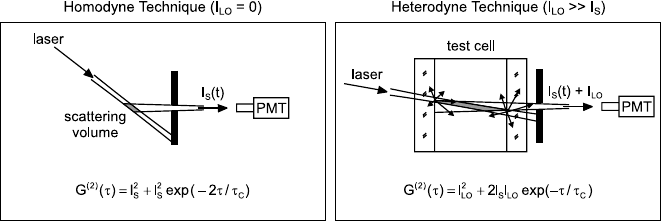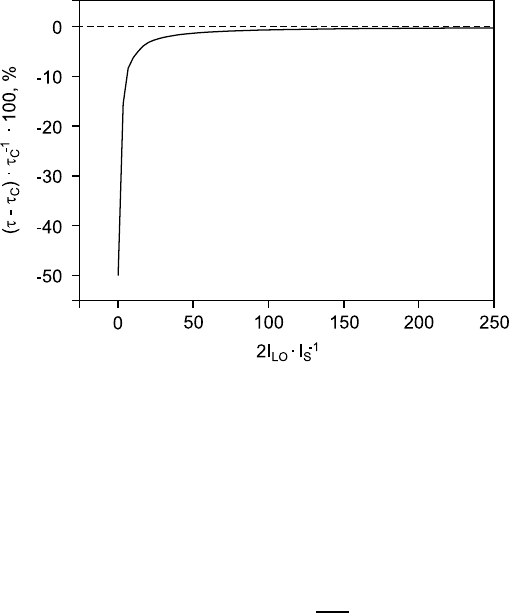Heitjans P., Karger J. (Eds.). Diffusion in Condensed Matter: Methods, Materials, Models
Подождите немного. Документ загружается.


580 Alfred Leipertz and Andreas P. Fr¨oba
temporal analysis of scattered light, and gives additionally some informa-
tion on related techniques, namely surface light scattering (SLS), where light
scattered from liquid/vapour interfaces is analysed, and forced Rayleigh scat-
tering (FRS), where an additional thermal grating is employed. It is a revised
and significantly extended version of the chapter published in the first edition
of this textbook [6].
15.2 Basic Principles
15.2.1 Spectrum of Scattered Light
When coherent light in form of a plane wave E
I
= E
0
exp[i(k
I
r − ω
I
t)] with
electric field amplitude E
0
, wave vector k
I
, and frequency ω
I
impinges on an
isotropic fluid sample with permittivity , the scattered field at a sufficiently
large distance R from the scattering volume V with electric susceptibility
fluctuations ∆χ
e
is found to be (for details, see, e.g., Chap. 16 and [7,8])
E
S
(R,t)=k
S
× (k
S
× E
0
)
0
exp [i(k
S
R − ω
I
t)]
4πR
×
V
∆χ
e
(r
,t) exp [i(k
I
− k
S
)r
]dr
.
(15.1)
Here,
0
denotes the permittivity in vacuo, and k
S
the wave vector of the
scattered light. By the difference between the wave vector of the incident
light and that one of the scattered light the scattering vector q = k
I
− k
S
is
defined. For a quasielastic scattering process, i. e. for k
I
∼
=
k
S
, the modulus
of the scattering vector directly follows from the geometry, see Fig. 15.1,
q = |k
I
− k
S
|
∼
=
2k
I
sin(Θ
S
/2) =
4πn
λ
0
sin Θ
S
/2, (15.2)
Fig. 15.1. Scattering geometry.

15 Diffusion Measurements in Fluids by Dynamic Light Scattering 581
Fig. 15.2. Schematic representation of the spectrum of scattered light for a binary
fluid mixture.
where n is the refractive index of the fluid, λ
0
is the wavelength of the light
in vacuo, and Θ
S
is the scattering angle.
It is the key feature of the DLS technique to analyse the fluctuations in the
electric susceptibility ∆χ
e
. In a fluid in macroscopic thermodynamic equilib-
rium, the local statistical fluctuations in the electric susceptibility are caused
by microscopic fluctuations of temperature (or entropy), of pressure, and of
species concentration in mixtures. The relaxations of these statistical fluctu-
ations follow the same rules which are valid for the relaxation of macroscopic
systems. Thus, the decay of temperature fluctuations is governed by the ther-
mal diffusivity a. Pressure fluctuations in fluids are moving with sound speed
c
S
and their decay is governed by the sound attenuation D
S
. In a binary fluid
mixture the decay of concentration fluctuations is governed by the mutual
diffusion coefficient. Altogether, these fluctuations result in a characteristic
spectrum of the scattered light [7] which is shown schematically in Fig. 15.2.
The temperature and/or concentration fluctuations contribute to the cen-
tral or frequency-unshifted Rayleigh component of the spectrum of the scat-
tered light. The pressure fluctuations cause the Brillouin lines which are
shifted by ω
S
relative to the frequency ω
I
of the incident light. The widths
of these three lines, which in good approximation all exhibit a Lorentzian
form, yield information on the relaxation of the fluctuations in the fluid and
thus on the transport properties. In particular, the widths of the Brillouin
lines are governed by the attenuation of sound D
S
, the width of the Rayleigh
line is determined by the thermal diffusivity a, and, in case of a binary fluid
mixture, also by the mutual diffusion coefficient D
12
. Additionally, the fre-

582 Alfred Leipertz and Andreas P. Fr¨oba
quency spacing ω
S
between the Rayleigh and Brillouin lines is proportional
to the speed of sound c
S
, and the ratio of the intensities of the Rayleigh and
the Brillouin lines results in the Landau-Placzek ratio S = I
R
/(2I
B
), which
contains information on the specific heats, c
p
and c
v
, at constant pressure
and constant volume, respectively. When adding spherical particles to the
fluid, the width of the Rayleigh line is governed by the particle diffusion
coefficient D
P
, which is related to the particle diameter and the dynamic
viscosity. Thus, several different thermophysical properties of interest can be
determined nearly simultaneously by analysing the spectrum of the scattered
light.
15.2.2 Correlation Technique
The use of classical interference spectroscopy (Fabry-Perot spectroscopy)
seems to be the straightforward way to analyse the Rayleigh-Brillouin triplet.
This filtering scheme is, however, only possible under special conditions, for
instance in the transition region from the kinetic to the hydrodynamic regime
where the Rayleigh line is relatively broad [9, 10]. Usually, the width of the
Rayleigh lines of order MHz or below for most cases of practical interest is
such small that it is far beyond the resolving power of Fabry-Perot interferom-
eters. This is the reason for analysing the spectrum of the scattered light in a
post-detection filtering scheme where the total intensity is first detected and
the detector signal is later filtered and processed. In this type of detection
one measures optionally the second-order power spectrum of the scattered
light or, as is described in some detail in the following, the time-dependent
intensity correlation function which also is named second-order correlation
function
G
(2)
(τ) ≡I(0)I(τ) = lim
T →∞
1
2T
T
−T
I(t)I(t + τ)dt. (15.3)
The brackets indicate the time average of the product I(t)I(t + τ ). The
spectral range has an upper limit of about 20 MHz corresponding to the time
resolution of the correlator instrument.
In general, the time correlation function gives information on the degree
to which two dynamical properties are correlated over a considered period of
time. In the following we first discuss some of the basic properties of these
functions which are relevant to our understanding of light-scattering spec-
troscopy. The time-dependence of the intensity I(t) will generally resemble
a noise pattern. The noise signal in Fig. 15.3 shows that the intensity at the
two times t and t + τ can in general have different values. However, when
τ is very small compared to the period of the fluctuations in the intensity,
I(t + τ ) will be very close to I(t) and thus both values are correlated. If τ
increases, I(t + τ)andI(t) become more and more different. The correlation
between both values is lost if τ becomes large compared to times typify-
ing the fluctuations in the intensity. A measure of this correlation is the

15 Diffusion Measurements in Fluids by Dynamic Light Scattering 583
Fig. 15.3. Time-dependence of the intensity I(t) (left) and its time-correlation
function I(0)I(τ ) (right).
correlation function or strictly speaking the autocorrelation function (ACF),
which is defined by (15.3). Here, it is assumed that the infinite time average
(T →∞) of the intensity is independent of its starting value. Such a prop-
erty is called a stationary property. In the case of non-periodic fluctuations
of a stationary property the correlation function starts from its initial value
I
2
= I(0)I(0) which is a maximum and decays to I
2
= I(0)I(τ) as
I(t+ τ)andI(t) become statistically independent for long times τ →∞.The
exact form of the correlation function depends on the underlying scattering
process and on the experimental conditions which is discussed in more detail
later in this chapter. In many applications the correlation function decays
like a single exponential. Here the decay time τ
C
is the time for which the
time-dependent part of the correlation function has decayed to the fraction
1/e of its initial value. The decay time τ
C
reflects the mean decay behavior
or life-time of the fluctuations of a particular property. This is characteristic
for the decorrelation of signals.
In a realistic experimental situation, besides the light scattered from the
fluctuations in a sample, also contributions from stray light, e.g., from dust on
the cell windows or from the cell windows themselves, may occur. Therefore,
for a general description, we consider a local oscillator field coherent with the
incident electric field. In terms of the total electric field E(t)=E
S
(t)+E
LO
(t),
which represents a superposition of the scattered electric field E
S
(t)withthe
local oscillator field E
LO
(t), the intensity or, more precisely, the radiative flux
I(t)=
c
2
E
∗
(t)E(t), (15.4)
measured by a detector, is given by

584 Alfred Leipertz and Andreas P. Fr¨oba
I(t)=
c
2
E
S
(t)+E
LO
(t)
2
= I
S
(t)+I
LO
(t)+
c
2
E
∗
S
(t)E
LO
(t)+E
∗
LO
(t)E
S
(t)
,
(15.5)
where the asterisk denotes the complex conjugate variable, c the speed of
light, and the permittivity of the medium. In the following the time de-
pendence of the electric field of the incident light at a fixed space point will
be considered more precisely by E
I
(t)=E
0
exp [−iω
I
t +iΨ(t)], where Ψ(t)is
a slowly varying random function representing fluctuations in the phase of
the incident light. The characteristic time behavior of the fluctuations in the
phase is determined by the inverse linewidth of the incident light. Further-
more, the scattered electric field can be written in the form E
S
(t)=f(t)E
I
(t),
where f(t) is a stochastic complex quantity being proportional to the fluctu-
ations in the electric susceptibility
f(t) ∝ ∆χ
eq
(t)=
⎧
⎪
⎪
⎩
∂χ
e
∂H
⎫
⎪
⎪
⎭
∆H
q
(t), (15.6)
with ∆χ
eq
(t)and∆H
q
(t) being the Fourier amplitudes of ∆χ
e
(r,t)and
∆H(r,t) of a fluctuation with wave vector q, respectively [11]. Here, H
may be identified with the temperature (or entropy), pressure, and species
concentration in fluid mixtures. For a general description also the electric
field of a local oscillator will be considered in terms of the incident field by
E
LO
(t)=f
LO
E
I
(t) with a constant strength f
LO
. In calculating (15.3) one
obtains from the product I(t)I(t + τ) sixteen terms, whereby as a result of
taking the time average only the six terms
I
S
(t)I
S
(t + τ)+I
LO
(t)I
LO
(t + τ)+I
S
(t)I
LO
(t + τ)+I
LO
(t)I
S
(t + τ)
+
c
2
2
4
E
∗
S
(t)E
LO
(t)E
∗
LO
(t + τ)E
S
(t + τ)+c.c.
(15.7)
show a non-vanishing contribution to the intensity correlation function. The
abbreviation c.c. stands for complex conjugate. In taking the time average
of (15.7) the first term I
S
(t)I
S
(t + τ) corresponds to the intensity correlation
function of the scattered light,
G
(2)
S
(τ)=I
S
(0)I
S
(τ) =
c
2
2
4
E
∗
S
(0)E
S
(0)E
∗
S
(τ)E
S
(τ), (15.8)
where a local oscillator is absent. For a Gaussian field, which is characterized
in a way that at a point of observation many individual components add
to the electric field and that the phase functions of these contributions are
equally distributed and mutually independent, the Siegert relation [8]
G
(2)
S
(τ)=
c
2
2
4
G
(1)
S
(0)
2
+
G
(1)
S
(τ)
2
, (15.9)

15 Diffusion Measurements in Fluids by Dynamic Light Scattering 585
holds, which connects G
(2)
S
(τ) with the field correlation function (first-order
correlation function)
G
(1)
S
(τ) ≡E
∗
S
(0)E
S
(τ) = lim
T →∞
1
2T
T
−T
E
∗
S
(t)E
S
(t + τ)dt. (15.10)
The optical or first-order power spectrum S
E
(ω) accessible by classical inter-
ference spectroscopy is, according to the Wiener-Khintchine theorem, directly
connected with G
(1)
S
(τ) by a Fourier transform
S
E
(ω)=
1
2π
+∞
−∞
G
(1)
S
(τ)exp(iωτ)dτ. (15.11)
Substituting the above stated expressions for the electric field of the incident
and scattered light E
I
(t)andE
S
(t), respectively, into (15.10) one obtains for
the first-order correlation function
G
(1)
S
(τ)=|E
0
|
2
exp [−iΨ(0) + iΨ (τ)]f
∗
(0)f(τ)exp (−iω
I
τ), (15.12)
where the correlation functions of f (t)andexp[iΨ(τ)] are separated since the
laser source and the medium can be considered statistically independent of
each other. As can be seen from (15.12), the optical power spectrum, which
is the Fourier transform of G
(1)
S
(τ), see (15.11), is in part determined by the
phase fluctuations of the incident light. Thus, a further limiting factor of clas-
sical interference spectroscopy is obvious. If the spectral width of the incident
light is larger than the width of the spectrum governed by the microscopic
fluctuations in the electric susceptibility, the field correlation function of the
scattered light and hence the optical power spectrum is dominated by the
phase fluctuations of the incident light. In contrast, the phase fluctuations of
the incident light cancel out in the second order power spectrum or in the
corresponding intensity correlation function of the scattered light
G
(2)
S
(τ)=I
2
S
+ I
2
S
|f
∗
(0)f(τ)|
2
f
∗
(0)f(0)
−2
, (15.13)
which is obtained by substituting (15.12) into the Siegert relation (15.9). In
deriving (15.13) it has been assumed that only one individual component
dominates the spectrum of the scattered light. This is equivalent to say that
only fluctuations in one property H of the medium cause fluctuations in its
electric susceptibility. In (15.13) I
S
denotes the time average of the scattering
intensity
I
S
=
c
2
|E
0
|
2
f
∗
(0)f(0), (15.14)
originated by the fluctuations in the quantity H. With the help of (15.13)
and (15.14) and taking into account that there is no interaction between
the intensity of the local oscillator and the intensity of the scattered light,
one obtains by taking the time average of (15.7) for the intensity correlation
function in the presence of a local oscillator field

586 Alfred Leipertz and Andreas P. Fr¨oba
G
(2)
(τ)=(I
S
+ I
LO
)
2
+ I
2
S
|f
∗
(0)f(τ)|
2
f
∗
(0)f(0)
−2
+2I
S
I
LO
f
∗
(0)f(τ)f
∗
(0)f(0)
−1
,
(15.15)
where the time average of the intensity of the local oscillator is given by
I
LO
=
c
2
f
2
LO
|E
0
|
2
. (15.16)
Since the stochastic function f (t) is proportional to the fluctuations ∆H
q
(t),
see (15.5), with the help of their normalized time correlation function,
g
q
(τ)=∆H
∗
q
(0)∆H
q
(τ)∆H
∗
q
(0)∆H
q
(0)
−1
, (15.17)
(15.15) can be rewritten by
G
(2)
(τ)=(I
S
+ I
LO
)
2
+ I
2
S
|g
q
(τ)|
2
+2I
S
I
LO
g
q
(τ). (15.18)
Thus it appears that the intensity correlation function accessible in light scat-
tering experiments gives access to the correlation function of the fluctuations.
In the case of a fluid in the hydrodynamic regime where the mean free path
length r
0
of the molecules is much smaller than the reciprocal value 1/q of
the modulus of the scattering vector (qr
0
1) and by this Onsager regres-
sion hypothesis holds, the time correlation functions of the fluctuations in
the thermophysical properties of state can be derived on the basis of classical
hydrodynamics. Because the fluctuations around the equilibrium values of
temperature (or entropy), pressure, and in addition of species concentration
in fluid mixtures are expected to be very small, the set of the linearized equa-
tions of fluid mechanics can be used. For the hydrodynamic modes of a fluid
the correlation functions g
q
(τ) can be found ultimately from the linearized
hydrodynamic equations by applying a Fourier-Laplace analysis [7]. As for
many other non-periodic statistical processes, such as for the diffusion of par-
ticles in dispersions, also for the statistical fluctuations of temperature (or
entropy) and species concentration in a fluid mixture, the normalized time
correlation function decays like a single exponential,
g
q
(τ)=exp(−τ/τ
C
), (15.19)
where τ
C
=(Dq
2
)
−1
is called the “relaxation time” or the correlation time
of the property. Here, D may be identified to be the thermal diffusivity a,
the mutual diffusion coefficient D
12
or the particle diffusion coefficient D
P
,
respectively. For the local pressure fluctuations at constant entropy, which
can be represented, to a good approximation, by propagating sound waves,
the normalized time correlation function has the form
g
q
(τ)=cos(ω
S
τ)exp(−τ/τ
C
), (15.20)
where the correlation time τ
C
=(D
S
q
2
)
−1
is related to the sound attenuation
D
S
. In addition, the frequency ω
S
= c
S
q, which is identical with the frequency

15 Diffusion Measurements in Fluids by Dynamic Light Scattering 587
of the sound waves observed, gives information about the sound velocity.
Actually, even the correlation function g
q
(τ) of a pure fluid does not consist
of a simple exponential or damped oscillation, as the fluctuations in pressure
and temperature are present simultaneously. The situation complicates, when
fluid mixtures or particle dispersions are considered. However, as decay times
and/or signal amplitudes are vastly different in many experimental situations,
the ACF in a time interval of interest may often be analysed in terms of a
simple exponential. This point will be described in more detail in the following
sections.
15.2.3 Homodyne and Heterodyne Techniques
As can be seen from (15.18) in the presence of a local oscillator field the
correlation function consists of three terms, the constant term (I
S
+ I
LO
)
2
,
the term I
2
S
|g
q
(τ)|
2
, which is due to the scattered light alone and is denoted
as homodyne term, and the heterodyne term 2I
S
I
LO
g
q
(τ). In the case that
the correlation function of the hydrodynamic fluctuations g
q
(τ) decays like
a single exponential we obtain two exponential functions with decay times
being different by a factor of two added to a constant background
G
(2)
(τ)=(I
S
+ I
LO
)
2
+ I
2
S
exp (−2τ/τ
C
)+2I
S
I
LO
exp (τ/τ
C
). (15.21)
As it is very difficult to extract reliable information from a sum of two ex-
ponentials with decay times of the same order of magnitude, the aim of the
experimenter is to meet a situation where one of the exponentials clearly
dominates. Either, one has to design the experiment (see Fig. 15.4) in a way
that only light from the sample itself is collected by the detector, I
LO
I
S
.
In this homodyne case, which may be the easier realized the larger the scat-
tering cross section of the fluctuations is, the normalized intensity correlation
function takes the form
g
(2)
(τ)=1+exp(−2τ/τ
C
). (15.22)
Fig. 15.4. Homodyne and heterodyne detection scheme.

588 Alfred Leipertz and Andreas P. Fr¨oba
Fig. 15.5. Error in the decay time τ
C
for a heterodyne experiment introduced if
the ratio 2I
LO
/I
S
of local oscillator to scattered light signals is not chosen large
enough.
Alternatively, the strict heterodyne case is achieved. This will be done, if
the signal is comparatively weak, and may be accomplished by deliberately
adding some part of the incident beam to the detected signal in a way that
I
LO
I
S
. Now the normalized intensity correlation function has the form
g
(2)
(τ)=1+
2I
S
I
LO
exp (−τ/τ
C
). (15.23)
It is crucial, however, in either case to make sure that one contribution
clearly dominates. If not, there may be a considerable error, see Fig. 15.5, as
the decay time determined from a fit to a supposed single exponential may
be anywhere in between the two cases. As can be seen from Fig. 15.5 it is
possible to achieve high accuracy in τ
C
by simply adding enough reference
light I
LO
to the signal I
S
in the heterodyne technique. A similar solution is
not given for the homodyne technique.
The derivation of (15.22) and (15.23), however, makes implicitly use of
two idealizing assumptions, which in general do not hold. One simplification
is that the scattered light is detected at a point in the far field. In practice,
both the scattering volume and the area of detection are finite, which results
in a deviation from an ideal coherent detection. Thus, there is an averaging
effect with a reduction of the contrast b = g
(2)
(0) − 1 as compared to the
value for a perfect registration. The deviation of b from 1 or 2I
S
/I
LO
in the
case of a homodyne or heterodyne detection scheme, respectively, also takes
into account effects of a finite speed of signal processing. Another simplifi-
cation is the assumption of a constant intensity of the incident light. Slow
fluctuations in the light source result in a deviation of the baseline from the
15 Diffusion Measurements in Fluids by Dynamic Light Scattering 589
ideal value 1 for the correlation function. Here, another adjustable parameter
a is introduced in practice. Thus, a practical ACF takes the form
g
(2)
(τ)=a + b exp (−2τ/τ
C
). (15.24)
or
g
(2)
(τ)=a + b exp (−τ/τ
C
). (15.25)
assuming homodyne or heterodyne conditions, respectively.
The application of the heterodyne technique is advantageous for achieving
high accuracy in the determination of τ
C
, see Fig. 15.5, and is especially useful
for the evaluation of the periodic pressure fluctuations at constant entropy,
which are responsible for the Brillouin components of the spectrum. In the
case of a pure fluid a usual homodyne intensity ACF exhibits terms due to
both pressure and temperature (or entropy) fluctuations and an additional
cross term. To analyze the pressure fluctuations in a heterodyne detection
scheme, the frequency of the local oscillator is shifted relative to the fre-
quency ω
I
of the laser light by ω
M
applying an acousto-optical modulator.
The frequency shift ω
M
is of the same order of magnitude as the frequency ω
S
of the pressure fluctuations observed (ω
M
≈ ω
S
). By a proper choice of the
intensity of the local oscillator shifted in frequency the signal governed by the
periodic pressure fluctuations may be strongly enhanced as compared to that
of the temperature (or entropy) fluctuations, and the correlation function
takes the form of a damped oscillation
g
(2)
(τ)=a + b cos (∆ωτ)exp(−τ/τ
C
). (15.26)
Now the speed of sound c
S
can be found from the knowledge of the adjusted
modulator frequency ω
M
and the residual detuning ∆ω = |ω
S
− ω
M
| of the
correlation function according to c
S
= ω
S
/q =(ω
M
± ∆ω)/q. As mentioned
above, the sound attenuation D
S
can be determined from the correlation time
τ
C
=(D
S
q
2
)
−1
.
15.3 The Dynamic Light Scattering Experiment
15.3.1 Setup
In this section some fundamentals of the design of a light scattering appara-
tus are discussed. The exact choice of the individual components naturally
depends strongly on the exact goal of the experiments, i. e., which property is
to be measured. A possible setup is displayed schematically in Fig. 15.6. The
main portion of the laser light is irradiated into a thermostated sample cell,
beam splitters allow one to add some reference light for a heterodyne detec-
tion, the frequency of which may be shifted for measurements on the Brillouin
lines. Part of the scattered light is imaged, in the simplest case only by means
